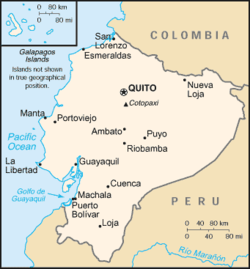 | |
| Data | |
|---|---|
| Access to an at least basic water source | 93% (2015) [1] [2] |
| Access to at least basic sanitation | 86% (2015) [1] [2] |
| Continuity of supply | 50% in urban areas |
| Financing | Subsidies and loans, both internal and external |
| Institutions | |
| Decentralization to municipalities | Full |
| National water and sanitation company | No |
| Water and sanitation regulator | No |
| Responsibility for policy setting | Ministry of Urban Development and Housing |
| Sector law | No |
| No. of urban service providers | 219 |
| No. of rural service providers | more than 5,000 |
Drinking water supply and sanitation in Ecuador is characterized by a number of achievements and challenges. One key achievement is a significant increase in both access to an at least basic water source (90% in 2000 to 100% in 2015 in urban areas) [1] and at least basic sanitation (82% in 2000 to 89% in 2015 in urban areas). Significant increases in coverage in urban areas were achieved both by the public utility EMAAP-Q, serving the capital Quito, and the private concessionaire Interagua in the country's largest city Guayaquil. However, municipalities rely overwhelmingly upon central government investment, rather than recouping the costs at a local level. Another problem is intermittent water supply, which affects half of the urban areas. Also, only 8% of all collected wastewater is being treated. The level of non-revenue water is estimated at 65%, one of the highest in Latin America. Addressing these challenges is complicated by the atomization of the sector: A multitude of stakeholders – the Ministry of Housing, the Emergency Social Investment Fund, the Solidarity Fund, the State Bank, NGOs, municipalities and others – intervene in the sector. Despite the existence of an Interinstitutional Committee for Water and Sanitation there remains room to improve coordination.
Contents
- Access
- Service quality
- History and Recent Developments
- Responsibility for water supply and sanitation
- Policy
- Service Provision
- Efficiency
- Financial aspects
- Tariffs, Cost Recovery and Affordability
- Investment and financing
- Success stories
- EMAAP-Q, the public enterprise serving Quito
- Interagua, the private concessionnaire serving Guayaquil
- External support
- World Bank
- Interamerican Development Bank (IDB)
- European Union
- Belgium
- International Organization for Migration
- CARE
- Small NGOs
- See also
- References
- External links




